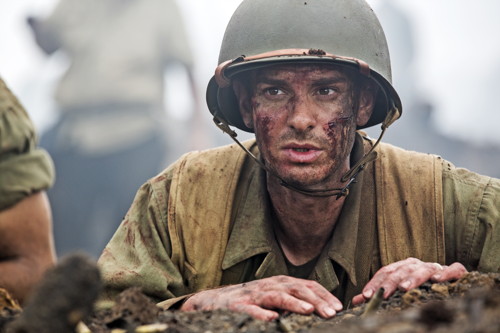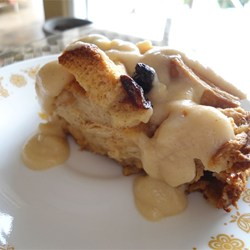Hacksaw Ridge: Virginia Bread Pudding Recipe 🥁🥁🥁🥁🥁
/Year Released: 2016
Directed by: Mel Gibson
Starring: Andrew Garfield, Teresa Palmer. Vince Vaughn
(R, 139 min.)
Genre: Action and Adventiure, Drama

“Please, Lord, let me get one more. Help me get one more.” Desmond Doss
I’m going to call this one early. Hacksaw Ridge is the best picture of 2016. Now, if only the Academy will have the wisdom to make it so.
But first something about what Oscars used to be.
Used to be Best Picture nominees, let alone winners, were sweeping epics that captured bigger than life characters. They might be based on real life heroes, like Lawrence of Arabia (1962), Patton (1970), Gandhi (1982), Schindler’s List (1993), Braveheart (1995) or The King’s Speech (2010).
Maybe they caught momentous times from the point of view of the little guy; i.e., Casablanca (1943), From Here to Eternity (1953), In the Heat of the Night (1967), Driving Miss Daisy (1989) Forrest Gump (1994), Titanic (1997), The Hurt Locker (2009) Argo (2012) or 12 Years a Slave (2013).
But most of all, they generally have been movies that the public went to see. (So far, Hacksaw Ridge has a firm box office, but not of blockbuster proportions – yet.)
Hacksaw Ridge has all these qualities and more. It’s Clint Eastwood’s American Sniper with its hero turned inside out. Desmond Doss volunteers to serve, but will not even touch a gun. And almost goes to military prison for refusing to carry one.
Director Mel Gibson chose well to tell the story of Desmond Doss (Andrew Garfield), the only conscientious objector ever to win a Congressional Medal of Honor. And the setting of World War II, the only fairly recent war we really won and one that had the full support of our people, sets the film apart as well. No anti war politics to clutter the screen for a change.
Instead we start with Desmond’s childhood in rural Virginia, where his father, an embittered alcoholic after losing almost all the friends he fought with in World War I, runs roughshod over his two boys and wife. In an early scuffle with his brother, Desmond hits him with a brick and knocks the boy out. The brother survives, but Desmond remembers how close he once came to taking a life.
When the war comes, he wants to serve, but only to save lives:
While everybody is taking life I’m going to be saving it, and that’s going to be my way to serve.
Before the film shifts to his enlistment, training, and the brutal realities of war, we have the very sweet love story between Desmond and the nurse he falls in love with at first sight. Tall and angular, a combination of Jimmy Stewart and a young Tony Perkins, Andrew Garfield’s Desmond woos her with shy determination. He gives blood just to be near her and then walks back to the hospital the next day to try to do it again. Nurse Dorothy flirts right back at him with the ritualized courtship that graced that era. An early stolen kiss gets a light slap, but only because he failed to ask for the kiss first. Just as in The Finest Hours, the romance is sweet and chaste, and it reminds us of simple times and a lost innocence that some may not even remember.
All of that rural beauty and banter sets us up for the brutality that follows. Neither the enlisted men nor the officers know how to cope with Private Doss, and they make his life as miserable as possible, thinking he is either crazy or a coward.
Their assignment to Hacksaw Ridge in Okinawa shows the horrors of war close up, and in true Mel Gibson style, the camera does not turn aside from the carnage, though I must admit I had to at times. The fog of war here is real, actual mist that unsettles the troops who cannot see where the enemy is. Grenades explode, limbs are torn asunder, and flamethrowers ignite the enemy troops like Fourth of July fireworks.
Doss is every bit as shocked and frightened as the other green recruits, but then he sees his mission and begins to rescue the wounded, comforting them with his words as well as his treatment. “I’m going to get you home,” he says, and carries or drags them to be evacuated, dodging gunfire all the way.
He even treats and rescues a few Japanese soldiers along the way as well.
The supporting characters are fleshed out, too, not the usual stereotypes we often get in combat films. We see his war weary father’s cruelty, yet also his anguish. The fellow soldiers who harass and even beat him are not brutes, but just frightened young men who cannot understand or respect a fellow soldier who does not carry arms. He is a weak link that could get them killed, a thought encouraged by his harsh drill Sergeant (Vince Vaughn):
Private Doss does not believe in violence. Do not rely on him to save you on the battlefield.
But slowly they recognize their errors in judgment as the wounded bodies abandoned on the Hacksaw Ridge start to pile up in the makeshift infirmary, courtesy of Private Doss. Their willingness to admit as much shines through the carnage.
I’ll let esteemed film critic Rex Reed finish this out for me:
… the best war film since Saving Private Ryan. It is violent, harrowing, heartbreaking and unforgettable. And yes, it was directed by Mel Gibson. He deserves a medal, too.
*I have copied the transcript of his Congressional Medal of Honor transcript below. It is unbelievable, but true. You can also read more about this real life hero here.
–Kathy Borich

Trailer
Film-Loving Foodie
Desmond Doss was from the hills of Virginia. He was the son of a carpenter. The food I have selected for this review goes along with his humble background. It is the kind of dessert his mother might have made, its simple ingredients readily available in most kitchens. Even with war rationing.
Another sweet thing about this recipe is the story about where its author found it, inside her mother’s Bible.
Desmond carried the Bible his wife gave him on their wedding day throughout the war. It was a great comfort to him. Read more about Desmond’s Bible in this article.
Virginia Bread Pudding
"We found this recipe tucked inside my mom's Bible when going through her things. It has become a family tradition on the first snow day of the year and if that doesn't happen, which can be the case here in central Virginia, we know it'll be the featured dessert at Easter and anytime a comfort food is in order." Gail Cobile
Ingredients
3 eggs, beaten
1 1/2 cups white sugar
2 tablespoons light brown sugar
1/2 teaspoon ground cinnamon
1/4 cup butter, melted
3 cups whole milk
10 slices hearty farmhouse-style bread, toasted and cut into cubes
1 cup raisins
1/2 cup light brown sugar
1 tablespoon all-purpose flour
1 pinch ground cinnamon
1 egg
2 tablespoons butter, melted
1 1/4 cups whole milk
1 pinch salt
1 tablespoon vanilla extract
Directions
Preheat oven to 375 degrees F (190 degrees C). Grease a 2-quart baking dish.
In a mixing bowl, whisk 3 eggs, white sugar, 2 tablespoons of light brown sugar, 1/2 teaspoon of cinnamon, 1/4 cup of butter, and 3 cups of whole milk together, and gently stir in the bread cubes and raisins. Lightly spoon the mixture into the prepared baking dish.
Bake in the preheated oven until browned and set in the middle, 50 to 55 minutes; cover the dish with foil after 30 minutes to prevent excessive browning. Let the pudding stand for 10 minutes before serving.
For vanilla sauce, whisk 1/2 cup of light brown sugar, the flour, a pinch of cinnamon, 1 egg, 2 tablespoons of melted butter, 1 1/4 cups of whole milk,and salt together in a heavy saucepan until smooth. Heat over medium heat, whisking constantly, until thickened and the sauce coats the back of a spoon, 10 to 12 minutes. Stir in the vanilla extract. Pour sauce over warm bread pudding, or serve on the side in a bowl.
*Transcript from Congressional Medal of Honor
Private First Class Desmond T. Doss, United States Army, Medical Detachment, 307th Infantry Regiment, 77th Infantry Division. Near Urasoe-Mura, Okinawa, Ryukyu Islands, 29 April - 21 May 1945. He was a company aid man when the 1st Battalion assaulted a jagged escarpment 400 feet high. As our troops gained the summit, a heavy concentration of artillery, mortar and machinegun fire crashed into them, inflicting approximately 75 casualties and driving the others back. Private First Class Doss refused to seek cover and remained in the fire-swept area with the many stricken, carrying them one by one to the edge of the escarpment and there lowering them on a rope-supported litter down the face of a cliff to friendly hands. On 2 May, he exposed himself to heavy rifle and mortar fire in rescuing a wounded man 200 yards forward of the lines on the same escarpment; and two days later he treated four men who had been cut down while assaulting a strongly defended cave, advancing through a shower of grenades to within eight yards of enemy forces in a cave's mouth, where he dressed his comrades' wounds before making four separate trips under fire to evacuate them to safety. On 5 May, he unhesitatingly braved enemy shelling and small-arms fire to assist an artillery officer. He applied bandages, moved his patient to a spot that offered protection from small-arms fire and, while artillery and mortar shells fell close by, painstakingly administered plasma. Later that day, when an American was severely wounded by fire from a cave, Private First Class Doss crawled to him where he had fallen 25 feet from the enemy position, rendered aid, and carried him 100 yards to safety while continually exposed to enemy fire.
On 21 May, in a night attack on high ground near Shuri, he remained in exposed territory while the rest of his company took cover, fearlessly risking the chance that he would be mistaken for an infiltrating Japanese and giving aid to the injured until he was himself seriously wounded in the legs by the explosion of a grenade. Rather than call another aid man from cover, he cared for his own injuries and waited five hours before litter bearers reached him and started carrying him to cover. The trio was caught in an enemy tank attack and Private First Class Doss, seeing a more critically wounded man nearby, crawled off the litter; and directed the bearers to give their first attention to the other man. Awaiting the litter bearers' return, he was again struck, this time suffering a compound fracture of one arm. With magnificent fortitude he bound a rifle stock to his shattered arm as a splint and then crawled 300 yards over rough terrain to the aid station. Through his outstanding bravery and unflinching determination in the face of desperately dangerous conditions Private First Class Doss saved the lives of many soldiers. His name became a symbol throughout the 77th Infantry Division for outstanding gallantry far above and beyond the call of duty.















